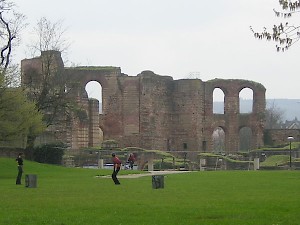Trier, Imperial Baths
Q697693Augusta Treverorum: important Roman city, modern Trier.

The complex that is known as Trier's Imperial Baths consists of two parts, which we always find together: the real baths (thermae) and a field on which people could perform athletic exercises (palaestra). The latter measures 160 x 130 meters; the baths themselves were added to the west and are about 90 meters deep.
The construction of this complex started shortly before 300, and can be attributed to the emperor Constantius I Chlorus (293-306), who moved his residence to Trier. In the northwestern part of the palaestra, older houses were demolished to create space. In 316, the baths were not yet finished, but work came to an end; the complex was, in other words, never finished.
In 353, the usurper Magnentius besieged the city (in vain) and in 360, Germanic tribes sacked Trier. After this, the Imperial Baths were no longer in use, and the emperors Gratian and Valentinian II used them as barracks. The old caldarium became a shrine for the standards. The complex was converted into a castle during the Middle Ages, just like the Baths of Barbara.
 Trier, Imperial baths, south side |
 Trier, Imperial baths, apse |
 Trier, Imperial baths, from the north |
 Trier, Imperial baths, model |